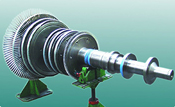OUR LOCATIONS
We can provide our services to power plants worldwide
Bradenton, Florida
941 - 527 - 6196
941 - 755 - 5229 (FAX)
Milwaukee, Wisconsin
414 - 698 - 5644
|

ROTOR BALANCING PHILOSOPHY
In all cases of observed vibration, the most important prerequisite to rotor balancing is to first identify the true root cause of the vibration, and determine if balancing is even an appropriate solution.
The application of rotor balancing might seem straightforward. During power plant operation, if plant operators observe warnings or alarms of high vibration amplitudes from displacement sensors, for any reason, the most common action is to put forth a request to “balance it”, assuming that any vibration is caused by “unbalance”. However, in practice the true cause and solution is rarely so simple, and in many cases this approach is not appropriate, and doesn’t address the true root cause of the vibration.
Synchronous vibration responses are created by any mass that is radially asymmetric, outside of the axis of the journals of the rotor train, as centrifugal force acts through the inertia of this asymmetric mass. This asymmetric mass might in special cases arise from localized unbalance, such as a machining error or a chipped blade. This type of flaw can be balanced if an appropriate balancing plane is available. But much more frequently, on assembled machines, vibration originates from rotor train misalignment that may have been caused by out-of-tolerance couplings or bearing positioning errors, or many other potential interrelated causes in an operating turbine.
It is an illusion that misalignment can be “balanced”. On rotor trains with rigid couplings, attempting to correct the effects of misalignment with balance weights only acts to distort the rotor train, create internal bending moments and increase bearing forces (also increasing bearing operating temperatures, and possibly even wiping the bearing). The true condition of the rotor can be worse after “balancing”, and can lead to greater, long-term damage.
In some other cases, vibration can be caused by significant rotor bows or distributed mass eccentricities. These cases can be properly balanced, but only on a balancing machine, using the proper and sufficient number of balancing planes (2N+1).
In all cases, before balancing can be considered as a solution, it is far more crucial to first determine the root cause of the observed vibration. Simply resorting to balancing as a first reaction to “high vibrations” is not a proper or viable approach, and it can often cause more harm than good if performed without thorough initial diagnostics.
Therefore, Z-R Consulting will not accept outright a request to perform balancing on a turbine-generator unit without first performing diagnostics to determine the true root cause of the vibration. With full facts and knowledge, balancing might then become one of the solutions - and would come with an assurance that it would resolve the problem, or in some cases, at least “patch” the problem temporarily to allow the unit to operate until a complete and proper repair can be performed.
|